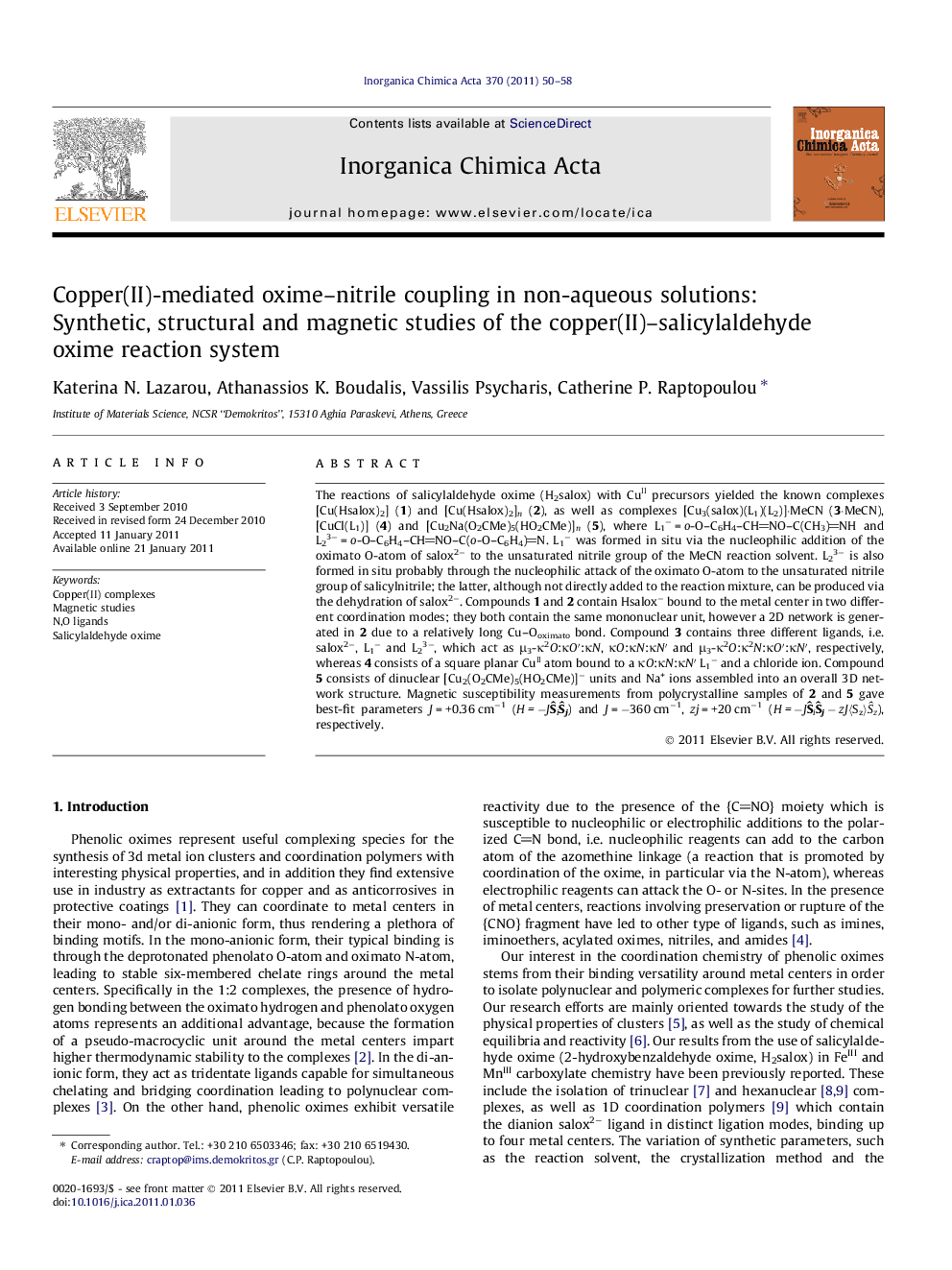| کد مقاله | کد نشریه | سال انتشار | مقاله انگلیسی | نسخه تمام متن |
|---|---|---|---|---|
| 1306257 | 1499208 | 2011 | 9 صفحه PDF | دانلود رایگان |

The reactions of salicylaldehyde oxime (H2salox) with CuII precursors yielded the known complexes [Cu(Hsalox)2] (1) and [Cu(Hsalox)2]n (2), as well as complexes [Cu3(salox)(L1)(L2)]·MeCN (3·MeCN), [CuCl(L1)] (4) and [Cu2Na(O2CMe)5(HO2CMe)]n (5), where L1− = o-O–C6H4–CHNO–C(CH3)NH and L23− = o-O–C6H4–CHNO–C(o-O–C6H4)N. L1− was formed in situ via the nucleophilic addition of the oximato O-atom of salox2− to the unsaturated nitrile group of the MeCN reaction solvent. L23− is also formed in situ probably through the nucleophilic attack of the oximato O-atom to the unsaturated nitrile group of salicylnitrile; the latter, although not directly added to the reaction mixture, can be produced via the dehydration of salox2−. Compounds 1 and 2 contain Hsalox− bound to the metal center in two different coordination modes; they both contain the same mononuclear unit, however a 2D network is generated in 2 due to a relatively long Cu–Ooximato bond. Compound 3 contains three different ligands, i.e. salox2−, L1− and L23−, which act as μ3-κ2O:κO′:κN, κO:κN:κN′ and μ3-κ2O:κ2N:κO′:κN′, respectively, whereas 4 consists of a square planar CuII atom bound to a κO:κN:κN′ L1− and a chloride ion. Compound 5 consists of dinuclear [Cu2(O2CMe)5(HO2CMe)]− units and Na+ ions assembled into an overall 3D network structure. Magnetic susceptibility measurements from polycrystalline samples of 2 and 5 gave best-fit parameters J = +0.36 cm−1 (H = −JŜiŜj) and J = −360 cm−1, zj = +20 cm−1 (H = −JŜiŜj − zJ〈Sz〉Ŝz), respectively.
The use of salicylaldehyde oxime (H2salox) in CuII chemistry yielded mononuclear and trinuclear complexes as well as 2D and 3D networks. The rich coordination chemistry and reactivity of H2salox was emerged in the ligation of Hsalox-, salox2− and the in situ formation and subsequent ligation of L1− (o-O–C6H4–CHNO–C(CH3)NH) and L23− (o-O–C6H4–CHNO–C(o-O–C6H4)N).Figure optionsDownload as PowerPoint slideResearch highlights
► In situ formation of ligand L1− (o-O–C6H4–CHNO–C(CH3)NH).
► Complexation of L1− through the phenolato-O, the oximato-N and the imino-N atoms.
► In situ formation of ligand L23− = o-O–C6H4–CHNO–C(o-O–C6H4)N.
► Complexation of L23− through the two phenolato O-atoms, the oximato and the imino N-atoms.
► Isolation of mono- and dinuclear complexes, as well as 2D and 3D coordination networks.
Journal: Inorganica Chimica Acta - Volume 370, Issue 1, 15 May 2011, Pages 50–58